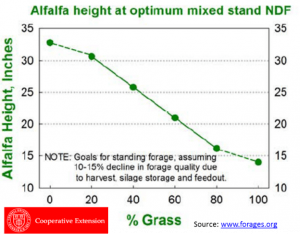This is the SCNY Team’s first full week of monitoring heights for first cutting quality in 2019. The full report for the six-county region can be found in the following link: Alfalfa Height Reporting Sheet 5.7.2019. The updated field map for measurements this year can be found here.
From Janice Degni, The SCNY Dairy & Field Crops Team’s Field Crop Specialist:
For the most part alfalfa came through the winter pretty well. Heaved plants can be found on wetter ground and in the wet areas of fields. Alfalfa is growing. On the heavier, wetter ground it is growing more slowly. Grass is growing well with the cooler temperatures and plentiful moisture. If we get some warmer temperatures in the next week or so, grass will change quickly from vegetative with low fiber, to reproductive with higher fiber.
We will be watching for signs of boot stage or near head emergence in grasses next week. If your field are less than 50% alfalfa and you want to harvest for peak quality, which we gauge by NDF levels between 50-55%, the grass may hit that stage in the next week to 10 days. It’s never fun when the haycrop is early and planting corn has progressed very slowly, if at all. General wisdom tells us that we gain more from higher quality in our hay crop than lost yield potential in the delayed corn planting. Use our measurements as an incentive to get around and check how your fields are growing.
-Janice
In general, fields in the southern counties of our region had alfalfa in the 14-16″ range, while fields to the northern end of our region had alfalfa averaging 10-12″ tall. This would put harvest of pure grass fields in the south in the next few days, and through the weekend in the north – sooner than most would like in either situation given the plentiful rainfall we’ve experienced. Mixed fields prediction falls somewhere around the 15th-20th, and with the weather forecast remaining in the mid-60’s for the next ten days, this may be the timing where many of the first crop mixed fields get harvested.
As always, being nimble and having the ability to shift strategy on fields to harvest will give you the best results. In reality, pure grass fields may not be able to be harvested on time for peak quality given the soggy conditions. Dedicating time to harvesting the mixed fields and pure alfalfa fields in a timely fashion while delaying corn planting will give you the best overall forage, and harvest those pure grass fields later for heifers or dry cows who don’t need the peak protein and fiber quality.
Taking the time now to focus on that dynamic harvest schedule might be the best use of a rainy day.
PRO-DAIRY’s Joe Lawrence offers some helpful links that have been previously released in other wet years:
Hi Folks,
I know the weather forecast varies a bit in different regions of the state but overall conditions for drying and field work do not look great. I hope things turn around but as I watched it rain again today I was thinking of some past resources we had put together that might be useful. Some of it is a bit dated but still has some relevant info.
As many of you ramp up the weekly alfalfa height monitoring, this feels like one of those years where producers may make the unfortunate decision to neglect timely hay harvest as they focus on corn planting. Given the cool start to the season timely harvest of first cutting could capture some exceptionally high quality feed.
Are you prepared to change your routine this spring?
Key Opportunities to Optimize 2018 Crop Production Efficiency
TIME TO CHECK THE PROGRESS OF YOUR FIRST CUTTING
Thanks,
Joe
jrl65@cornell.edu
As a reminder, for prediction of NDF content, the height of alfalfa as an indicator is as follows:
- 100% grass stands – cut when nearby alfalfa is 14 inches tall (achieves 50% NDF)
- 50/50 grass/alfalfa stands – cut when nearby alfalfa is 22 inches tall (achieves 44% NDF)
- 100% alfalfa stands – cut when alfalfa is 28 inches tall (achieve 40% NDF)
From Kevin Ganoe, the CNY Dairy, Livestock & Field Crops Team’s Forage Specialist:
Predicted days to cut are based on daily NDF increases for grasses of 1.0% point, 50/50 mixed alfalfa/grass stands of 0.8% points, and alfalfa of 0.5% points and are adjusted for the coming week’s weather. Typically NDF increases about 0.8 to 1.2 per day for grasses, with cooler weather being the lower end of the range and warmer weather being the higher end. For alfalfa, NDF increases about 0.4 to 0.7 per day, also dependent upon warm/cool weather.
The CNY Team’s May 7th report can be found at the following link: CNY 572019 1st cutting forage quality summary The CNY Dairy Livestock & Field Crops Team covers Chenango, Fulton, Herkimer, Madison, Montgomery, Otsego, Saratoga and Schoharie Counties in NY. Any questions about their report can be directed to Kevin Ganoe, khg2@cornell.edu.
Look for our next report of monitoring heights to come out on Wednesday, May 15th. In the meanwhile, if you can’t get out to check your fields, call one of us on the team. We’ll be glad to help out.
Credit to field measurements goes to Janice Degni, Melanie Palmer, Mary Kate Wheeler, Shona Ort and Betsy Hicks.



